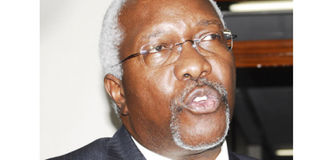70,000 get jobs in Middle East amid cracks in labour export

Auditor General John Muwanga
KAMPALA- The Ministry of Gender, Labour and Social Development has since 2015 through the labour externalisation programme ‘facilitated’ exportation of at least 70,000 Ugandans to work in the United Arab Emirates (UAE), Saudi Arabia, Jordan, Bahrain, Oman, Iraq, Somalia, Afghanistan and Mali.
The labour externalisation, a lucrative but controversial policy, is a government initiated “strategic initiative” to facilitate recruitment of Ugandan migrant workers in meaningful employment abroad and also to ensure that their rights and welfare are protected, in wake of unemployment levels currently surging past 87 per cent, according to National Planning Authority (NPA) statistics
Licensing private agencies
According to Auditor General John Muwanga, the ministry of Gender which is overseeing implementation of the policy, had by November last year also licensed 79 private recruitment agencies.
Mr Muwanga in the value for money audit of the ministry released in January, indicated that “in spite of some achievements” registered in streamlining the business there are several areas that need to be fixed, such as putting in place regulations and guidelines on recruitment and placement of migrant workers.
“The guidelines were not disseminated as planned because the revised regulations were yet to be approved,” Mr Muwanga said in the audit report.
Labour exporting firms
“This meant that key stakeholders central to the recruitment of migrant workers had limited information on the laws and processes on recruitment and management of migrant workers since they did not have copies of the regulations and guidelines,” he added.
The audit reveals that while the ministry had licensed 79 recruitment agencies, there is no evidence that updated lists of these agencies were being shared with key stakeholders.
“Further still, the ministry had in some cases issued recruitment licenses and approved job orders for companies that did not have valid bank guarantees. It was also noted that the penalty for operating without a license was not deterrent.”
A list of the labour exporting firms submitted to Parliament in October 2016 revealed that some of the firms were owned by senior government and military officials.
Statistics from the Labour department at the time showed that between 2006 and 2015, more than 50,000 Ugandan migrant workers were employed abroad through labour externalisation programme.
The highest number of Ugandan workers exported in a single year was 8,363 in 2010.
Migrating for work provides immense opportunities but not without challenges as is well known, especially in the Middle East.
Money remitted
According to 2015 Bank of Uganda statistics, migrant workers who have passed through the externalisation of labour programme remitted back home an average of $2m (Shs7b).
The latest audit, further, indicated that the ministry was yet to accredit any foreign principal/ employer and yet they were approving manpower requests from these foreign principals/employers.
In addition, the ministry was not verifying the manpower requests to establish the existence of the employing person, and its capacity to hire workers at acceptable rates and desirable conditions.
“The ministry is weak in enforcing compliance and ensuring that adequate due diligence was done,” the audit reads in part.
The audit faulted the ministry for failing to conduct routine inspection, spot inspections, and inspections before issuance of license or in case of transfer of office; the only inspections carried out were before issuance of license and on transfer of office.



